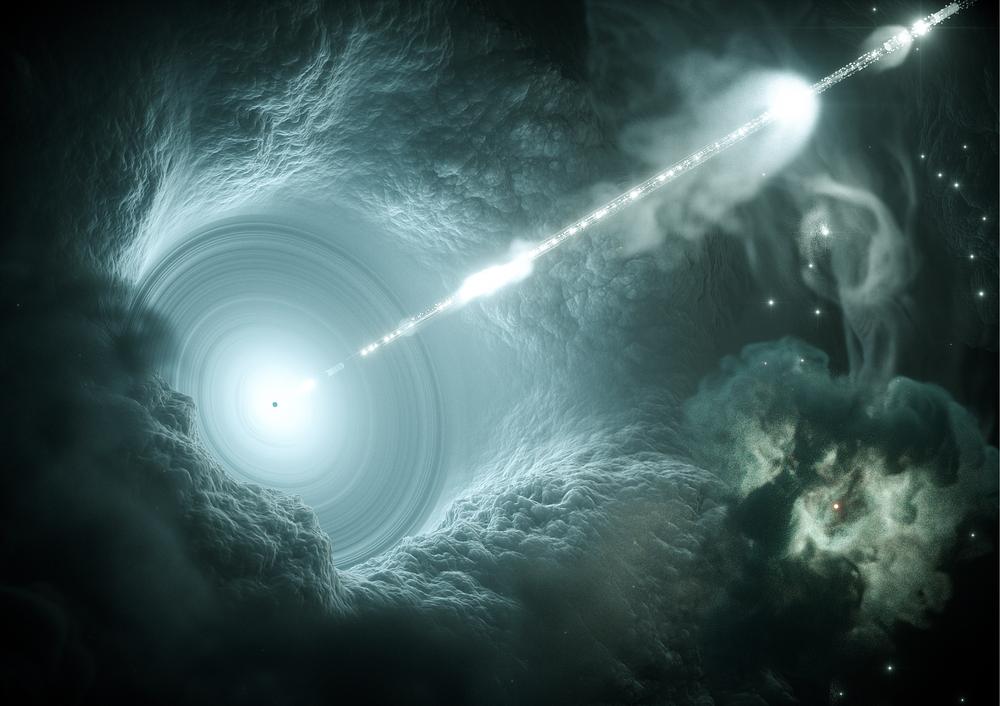In an astrophysics breakthrough, researchers have captured a blazar—a kind of galaxy—in the act of slinging out high-energy neutrinos. The discovery serves as the first-ever confirmation of a natural "particle accelerator" generating the energetic neutrinos. It also likely solves a century-old mystery regarding the origins of cosmic rays. These extremely energetic particles should be produced alongside neutrinos in particle accelerator–like environments, where matter is revved up to nearly the speed of light. See also: Cosmic ray; Galaxy; Light; Matter (physics); Neutrino; Neutrino astronomy; Particle accelerator; Photon; Physics

In September 2017, the IceCube Neutrino Observatory in Antarctica detected an exceptionally high-energy neutrino emanating from a confined region of the sky near the constellation of Orion. The detection set off an automatic alert to observatories around the world. Focusing in on this region, the Fermi Gamma-ray Space Telescope reported intense gamma rays from a blazar galaxy that, like a quasar, hosts an active supermassive black hole in its core. Quasars and blazars both produce powerful jets from the black hole's poles; in the case of blazars, a jet happens to point directly at Earth. Additional observations across a range of wavelengths further bolstered the blazar—designated TXS 0506+056, located 3.7 billion light years away—as the source of the potent neutrino in question. See also: Black hole; Constellation; Fermi Gamma-ray Space Telescope; Gamma-ray astronomy; Gamma rays; IceCube Neutrino Observatory
Previously, the Sun and Supernova 1987A stood as the only confirmed sources of astrophysical neutrinos, all of which possessed far less energy than the blazar-spawned variety. Neutrinos are virtually massless, elementary particles that rarely interact with other matter. Detecting them therefore requires large arrays, such as the cubic kilometer of sensor-studded ice monitored by the IceCube facility. See also: Elementary particle; Fundamental interactions; Solar neutrino; Sun; Supernova; Supernova 1987A
Neutrinos' aloofness, however, makes them an ideal probe for identifying the sources of cosmic rays. Cosmic rays, which are usually protons, can impact Earth's atmosphere with dozens of times the collisional energy attainable by the most powerful artificial particle accelerator, the Large Hadron Collider, located near Geneva, Switzerland. Possessing charge, cosmic rays are diverted by electromagnetic fields in space, making it impossible to trace any given ray back to a distinct source. Neutrinos, however, travel in straight lines through the cosmos, thus revealing their ultimate and, in many cases, likely shared origin point with cosmic rays. See also: Atmosphere; Earth; Large Hadron Collider (LHC); Proton
Overall, the findings should lend astrophysicists unprecedented insight into the inner workings of blazars and other extreme cosmic phenomena. Finally, the results represent the latest major milestone in the emerging field of multi-messenger astronomy. The field couples the traditional astronomical standard of light observations with neutrinos, cosmic rays, and gravitational waves in order to more fully understand the universe and its constituents. See also: High-energy astrophysics; Gravitational radiation





